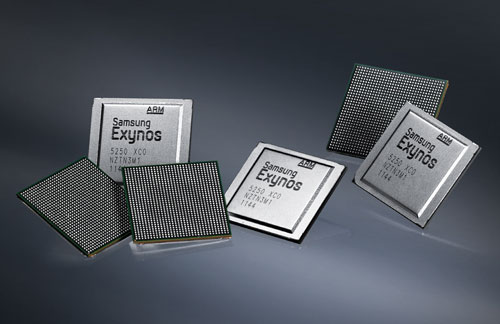Samsung Electronics has announced their very first dual-core processor samples based on the ARM Cortex-A15 core. The 2GHz dual-core Exynos 5250 processor is particularly designed for high-end tablets and utilizes 32nm high-k metal gate low-power process technology which offers system-level designers a new solution intended to meet the graphic-intensive, power-efficient requirements of these next-generation mobile products.

According to Samsung the new dual-core ARM Cortex-A15 based application processor is capable of processing 14 billion instructions per second (DMIPS, Dhrystone million instructions per second) at 2.0GHz, nearly doubling the performance over a current state of the art Cortex-A9-based dual core processor running at 1.5GHz capable of 7,500 DMIPS.
The Exynos 5250 design is also said to support display resolutions up to 2560 x 1600 (WQXGA). This enables users to enjoy crisper video images on their mobile devices and deliver readability equivalent to real paper for an ultimate electronic reading experience.
Other highlighted features include power efficiency thanks to an embedded DisplayPort (eDP) interface and advanced 3D graphics processing capabilities, enhanced by more than four-fold over the 1.5GHz Cortex-A9 dual-core processor, and a stereoscopic 3D feature raise the bar of user experience on high-specification 3D gaming, user-interfacing and stereoscopic 3D video playback. The processor also features a doubled memory bandwidth of 12.8 Gigabytes per second (GB/s) compared to current dual-core processors that support a maximum of 6.4GB/s to enable fast data processing features, superb 3D graphics and high-resolution display. This memory bandwidth is a key requirement for a processor to support WQXGA resolution displays.
Samsung’s Exynos 5250 offers a host of peripheral functions including an embedded image signal processor enabling 8 Megapixel resolution images at 30 frames per second, a full HD 60 frame per second video hardware codec engine for high resolution 1080p video recording and playback, a HDMI 1.4 interface for sharp and crisp multimedia content transmission, along with a diverse scope of embedded booting device interfaces such as SATA, UART, USB and external ports such as USB3.0, eMMC4.5 and eSD3.0.
The new processor is expected to hit tablets in mid-2012.
